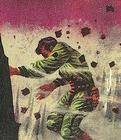
A brilliant nonfiction work of scientific journalism,
Mapping Mars: Science, Imagination, and the Birth of a World (2002), by science writer
Oliver Morton, “explores the peculiar and fascinating world of the new generation of explorers: geologists, scientists, astrophysicists and dreamers. Morton shows us the complex and beguiling role that mapping will play in our understanding of the red planet, and more deeply, what it means for humans to envision such heroic landscapes. Charting a path from the 19th century visionaries to the spy-satellite pioneers to the science fiction writers and the arctic explorers ... Morton unveils the central place that Mars has occupied in the human imagination, and what it will mean to realize these dreams.”
Specific science fiction works mentioned or discussed include:
• Birth of Fire (1976), by Jerry Pournelle
• Blue Mars (1996), by Kim Stanley Robinson
• “
The Difficulties Involved in Photographing Nix Olympica" (1986), by Brain Aldiss
• The Earth is Near (1973), children's book by Ludek Pesek
• The Far Call (1978), by Gordon R. Dickson
• First Landing (2001), by Robert Zubrin
• The Fountains of Paradise (1979), by Arthur C. Clarke
• Frontera (1984), by Lewis Shiner
• Genesis: an Epic Poem (1988), by Frederick Turner
• Green Mars (1994), by Kim Stanley Robinson
• Man Plus (1976), by Frederik Pohl
• “
The Man Who Lost the Sea” (1959), by Theodore Sturgeon
• Mars (2000), by Ben Bova
• Mars Crossing (2000), by Geoffrey A. Landis
• Mars Underground (1997), by William K. Hartmann
• The Martian Chronicles (1950), by Ray Bradbury
• The Martian Inca (1977), by Ian Watson
• The Martian Race (1999), by Gregory Benford
• Martian Time-Slip (1964), by Philip K. Dick
• Mission to Mars (Film, 2000)
• Moving Mars (1993), by Greg Bear
• Rainbow Mars (1999). by Larry Niven
• Red Mars (1992), by Kim Stanley Robinson
• Red Planet (Film, 2000)
• Red Planet (1949), by Robert A. Heinlein
• The Sands of Mars (1951), by Arthur C. Clarke
• The Secret of Life (2001), by Paul J. McAuley
• Stranger in a Strange Land (1961), by Robert A. Heinlein
• Voyage (1996), by Stephen Baxter
• Voyage to the Red Planet (1990), by Terry Bisson
• Watchmen (1987), graphic novel written by Alan Moore and drawn by Dave Gibbons
• White Mars, or, the Mind Set Free: a 21st-Century Utopia (1999), by Brian W. Aldiss and Roger Penrose
Reviews of Morton’s
Mapping Mars: Science, Imagination, and the Birth of a World from
Publisher’s Weekly and
Booklist are available at
Amazon.com.
Pictured above: “This map depicts
Barsoom/Mars as we know it today. The seas have dried up, the oceans have receded, and the plains are ruled by the savage green hordes. This is the Barsoom of the John Carter Era (J.C.E.).”
 Hugo Award-winning SF&F artist Frank Wu has embedded several of astronomer Percival Lowell’s infamous early 20th-century maps of the canals on Mars in a panel of his forthcoming Guidolon graphic novel.
Hugo Award-winning SF&F artist Frank Wu has embedded several of astronomer Percival Lowell’s infamous early 20th-century maps of the canals on Mars in a panel of his forthcoming Guidolon graphic novel..JPG)











